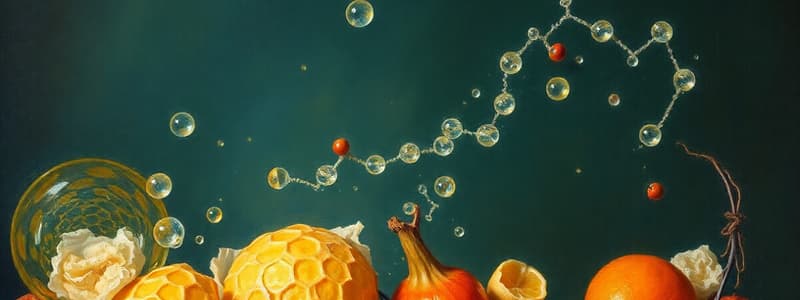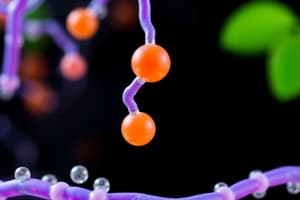Podcast
Questions and Answers
What is the structural difference between starch and glycogen?
What is the structural difference between starch and glycogen?
- Starch is primarily found in animal cells, while glycogen is found in plant cells.
- Starch is a linear polymer, while glycogen is a branched polymer. (correct)
- Starch is a branched polymer, while glycogen is a linear polymer.
- Starch is composed of fructose, while glycogen is composed of glucose.
Which of the following is a heteropolysaccharide?
Which of the following is a heteropolysaccharide?
- Starch
- Cellulose
- Glycogen
- Hyaluronic acid (correct)
What is the primary function of cellulose in plants?
What is the primary function of cellulose in plants?
- Cell signaling
- Hormone production
- Energy storage
- Structural support (correct)
What is the function of hyaluronic acid in the body?
What is the function of hyaluronic acid in the body?
Which of the following is NOT a characteristic that differentiates polysaccharides?
Which of the following is NOT a characteristic that differentiates polysaccharides?
What is the main product of glycolysis from one molecule of glucose?
What is the main product of glycolysis from one molecule of glucose?
Which of the following statements about the phases of glycolysis is correct?
Which of the following statements about the phases of glycolysis is correct?
Which enzyme activator is associated with fasting conditions?
Which enzyme activator is associated with fasting conditions?
Where does gluconeogenesis mainly occur in the body?
Where does gluconeogenesis mainly occur in the body?
From which of the following can gluconeogenesis generate glucose?
From which of the following can gluconeogenesis generate glucose?
What is the empirical formula for carbohydrates?
What is the empirical formula for carbohydrates?
Which group of carbohydrates consists of 2 to 10 monosaccharides?
Which group of carbohydrates consists of 2 to 10 monosaccharides?
Which of the following is a characteristic of hexoses?
Which of the following is a characteristic of hexoses?
What type of monosaccharide includes glucose and galactose?
What type of monosaccharide includes glucose and galactose?
Which of these is NOT a characteristic of carbohydrates?
Which of these is NOT a characteristic of carbohydrates?
What defines a heteropolysaccharide?
What defines a heteropolysaccharide?
Which of the following is a disaccharide?
Which of the following is a disaccharide?
What type of linkage connects monosaccharides in carbohydrates?
What type of linkage connects monosaccharides in carbohydrates?
What is the main function of the Cori cycle?
What is the main function of the Cori cycle?
Which of the following statements about gluconeogenesis is true?
Which of the following statements about gluconeogenesis is true?
What is the primary role of glycogen in the liver?
What is the primary role of glycogen in the liver?
What initiates glycogen breakdown in the muscle during physical activity?
What initiates glycogen breakdown in the muscle during physical activity?
Which hormone primarily activates glycogenesis?
Which hormone primarily activates glycogenesis?
How does gluconeogenesis differ from glycolysis?
How does gluconeogenesis differ from glycolysis?
Which of the following is an anabolic pathway?
Which of the following is an anabolic pathway?
What occurs during the well-fed state in carbohydrate metabolism?
What occurs during the well-fed state in carbohydrate metabolism?
Flashcards
Glycolysis
Glycolysis
A catabolic pathway that breaks down glucose into pyruvate.
Preparatory Phase
Preparatory Phase
The part of glycolysis where 2 ATP are consumed.
Payoff Phase
Payoff Phase
The part of glycolysis that produces 4 ATP and 2 NADH.
Gluconeogenesis
Gluconeogenesis
Signup and view all the flashcards
Regulation of Glycolysis
Regulation of Glycolysis
Signup and view all the flashcards
Polysaccharides
Polysaccharides
Signup and view all the flashcards
Homopolysaccharides
Homopolysaccharides
Signup and view all the flashcards
Heteropolysaccharides
Heteropolysaccharides
Signup and view all the flashcards
Starch
Starch
Signup and view all the flashcards
Glycogen
Glycogen
Signup and view all the flashcards
Carbohydrates
Carbohydrates
Signup and view all the flashcards
Monosaccharides
Monosaccharides
Signup and view all the flashcards
Oligosaccharides
Oligosaccharides
Signup and view all the flashcards
Aldoses
Aldoses
Signup and view all the flashcards
Ketoses
Ketoses
Signup and view all the flashcards
Disaccharides
Disaccharides
Signup and view all the flashcards
Glycosidic Bonds
Glycosidic Bonds
Signup and view all the flashcards
Cori Cycle
Cori Cycle
Signup and view all the flashcards
Glycogenolysis
Glycogenolysis
Signup and view all the flashcards
Glycogenesis
Glycogenesis
Signup and view all the flashcards
Regulation in Well-Fed State
Regulation in Well-Fed State
Signup and view all the flashcards
Regulation in Fasting State
Regulation in Fasting State
Signup and view all the flashcards
Study Notes
Carbohydrate Metabolism
- Carbohydrates are hydrosoluble molecules.
- Their empirical formula is (CH₂O)ₙ.
- Monosaccharides are the building blocks of larger carbohydrates.
- Monosaccharides function in energy storage, structural components, and cell identity markers.
- Glucose is a vital monosaccharide for energy generation.
Carbohydrate Classification
- Monosaccharides are simple sugars.
- Oligosaccharides consist of 2-10 monosaccharides bonded together by glycosidic bonds.
- Polysaccharides consist of more than 10 monosaccharides.
- Homopolysaccharides are made up of the same type of monosaccharide.
- Heteropolysaccharides contain more than one type of monosaccharide.
Monosaccharides
- Monosaccharides are classified based on the carbonyl group (aldehyde or ketone).
- Aldoses have an aldehyde group, whereas ketoses have a ketone group.
- Glucose, fructose, and galactose are important hexoses.
- Ribose is an important pentose.
Oligosaccharides
- Oligosaccharides are formed from 2 to 10 monosaccharides linked via glycosidic bonds.
- A common example is maltose.
- Disaccharides such as lactose and sucrose have defined compositions.
Polysaccharides
- Polysaccharides are polymers with more than 10 monosaccharide units.
- Starch and glycogen are storage forms of glucose in plants and animals, respectively.
- Starch is less branched than glycogen.
- Cellulose is a structural polysaccharide found in plant cell walls.
- Hyaluronic acid is a heteropolysaccharide, functioning as a lubricant.
Digestion of Carbohydrates
- Digestion begins in the mouth, using enzymes like α-amylase.
- Pancreatic α-amylase further breaks down starch.
- Oligosaccharides in the small intestine are broken down to monosaccharides by enzymes like lactase and sucrase.
- Monosaccharides are absorbed from the intestines.
Glucose Homeostasis
- Glucose is essential for brain function.
- After a meal, blood glucose rises, triggering insulin release.
- Insulin stimulates glucose uptake by cells and glycogen formation in the liver.
- During fasting, glucagon is released, promoting glycogen breakdown and gluconeogenesis.
Glycolysis
- Glycolysis is a universal central pathway for glucose catabolism.
- Glycolysis occurs in the cytoplasm.
- Glycolysis breaks down glucose into pyruvate, releasing ATP.
Gluconeogenesis
- Gluconeogenesis forms glucose from non-carbohydrate precursors.
- It's a vital pathway during fasting and exercise.
- Gluconeogenesis uses many but not all reversible steps of glycolysis.
Cori Cycle
- The Cori cycle is the metabolic pathway between skeletal muscle and the liver involving lactate, pyruvate, and glucose.
- During vigorous exercise, lactate produced by the muscles is transported to the liver.
Glycogen Metabolism
- Glycogen is the storage form of glucose in animals.
- Glycogenolysis breaks down glycogen to glucose.
- Glycogenesis synthesizes glycogen from glucose.
- Epinephrine and glucagon trigger glycogen breakdown.
- Insulin stimulates glycogen synthesis.
Regulation of Carbohydrate Metabolism
- Hormones like insulin and glucagon regulate carbohydrate metabolism by influencing glycogen synthesis and breakdown, and glucose uptake by cells (in a well-fed or fasting state).
- Exercise causes release of adrenaline, which influences glycogen breakdown and glycolysis.
Aerobic and Anaerobic Respiration
- Aerobic respiration involves oxygen and yields a large amount of ATP.
- Anaerobic respiration produces far less ATP, as in fermentation.
Studying That Suits You
Use AI to generate personalized quizzes and flashcards to suit your learning preferences.




